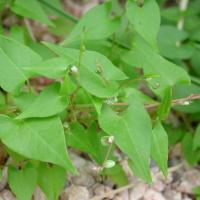Black bindweed
Fallopia convolvulus
Fallopia convolvulus, commonly known as black-bindweed or wild buckwheat, is an annual climbing plant belonging to the Polygonaceae family. Native to Europe and Asia, it has become naturalized in various parts of North America. Here's a detailed description of Fallopia convolvulus:
Description:
-
Habitat: Black-bindweed is commonly found in disturbed areas, agricultural fields, gardens, and along roadsides. It can adapt to a wide range of soil types.
-
Growth Form: This plant is a climbing or twining annual, capable of reaching lengths of 1 to 2 meters. It often climbs on and around other vegetation.
-
Leaves: The leaves are alternate, arrow-shaped, and have a triangular or hastate (spearhead-shaped) appearance. They are usually dark green.
-
Flowers: The small greenish-white to pinkish flowers are inconspicuous and are arranged in clusters in the leaf axils.
-
Blooming Period: Black-bindweed typically flowers from late spring to early fall.
-
Fruits: The fruit is a three-angled achene, characteristic of plants in the Polygonaceae family.
Identification Features:
-
Twining Habit: Black-bindweed climbs and twines around other plants for support.
-
Arrow-Shaped Leaves: The leaves have a distinct arrow or hastate shape.
-
Inconspicuous Flowers: The flowers are not highly showy and are often greenish-white to pinkish.
Ecological Role:
- Black-bindweed can be considered both a weed and a valuable species for wildlife. It provides food and habitat for certain insects and birds.
Invasiveness:
- In some regions, black-bindweed is considered invasive, particularly in agricultural settings where it can compete with crops.
Cultural Uses:
- While not cultivated for specific uses, black-bindweed has been historically used in traditional medicine in some cultures.












